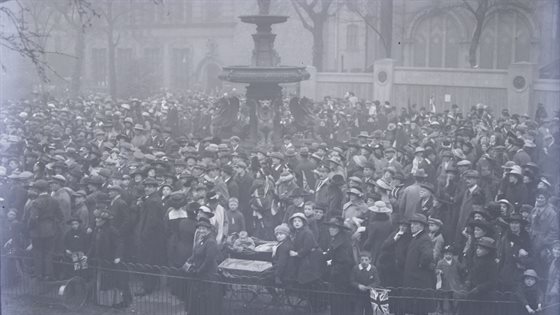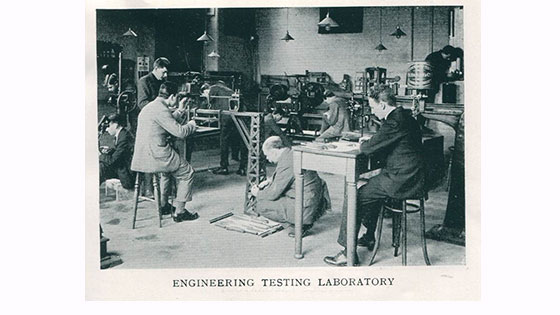An engineering teacher from Leicester was secretly recruited to help fight the German U-boat threat during the First World War.
Ernest Edward Brooks developed anti-submarine technology which the Admiralty said had been ‘of the greatest assistance’ in the war effort.
His work only came to light in 1917 after he had been working secretly for some time on the technology. Submarines were considered the greatest threat during the First World War as British ships had no way of knowing where they were. A U-boat was responsible for the sinking of the Lusitania liner, in which 1,200 people died.
Archivist Katharine Short discovered mention of Brooks’ work while researching the First World War and its impact upon Leicester Municipal Technical and Art School, predecessor of De Montfort University Leicester (DMU).

How Armistice Day was celebrated in Town Hall Square, Leicester, in 1918
Brooks, who taught at Leicester Technical School from 1884 to 1936, was an expert on magnetism and electricity. He was the Second Master of the school and also the Head of the Electrical Engineering Department.
Some 20 students and staff from the School were killed during the First World War. A roll of honour lists 177 people who served but there is no record of how many men from the Technical School served.
Their stories are being told in a new travelling exhibition created by DMU’s Special Collections department. It will tour the university and be open to the public. At its centre is a rare roll of honour which lists all the servicemen and women who lost their lives during the First World War. Only a handful of these records exist. The inscription reads: “All they had hoped for, all they had, they gave to save mankind.”
Among those who died was Julian Gould, who had studied drawing, design and lithography at the Art School. Originally a conscientious objector, he enlisted out of disgust at the sinking of the Lusitania. He was killed in action on 31 May 1917 at the age of 25. His grave is unknown and his name is recorded on the Arras Memorial.
Walter Anson was a star pupil of the Art School, where he studied painting and drawing. He had been praised by the art critic of The Observer newspaper. The Midland Free Press wrote in September 1912 that, ‘there is no doubt he will have a brilliant future’. Walter was killed at Gaza on 8 November 1917, aged 27.

The Engineering Testing Laboratory at Leicester Municipal Technical and Art School, where munitions were made
The Technical School converted its engineering workshop into a munitions factory to make shells and ammunition for the Ministry. The schools’ playing fields were taken over for military training and civilian Home Guard trained outside The Magazine.
From 1917, special classes for disabled ex-servicemen were started, helping those who needed to learn a new trade. Boot and shoe manufacture was the most popular.
The display will be available at the following locations:
Monday 12 to Sunday 18: Kimberlin Library Foyer
Monday 19 to Tuesday 20: Hugh Aston Atrium
Tuesday 20 to Wednesday 21: Vijay Patel, outside the Gallery
Thursday 22 to Friday 23: Campus Centre foyer
Sunday 25: Trinity Chapel during Meet the Archivists event - open to the public, 11am to 3pm.
Posted on Friday 9 November 2018